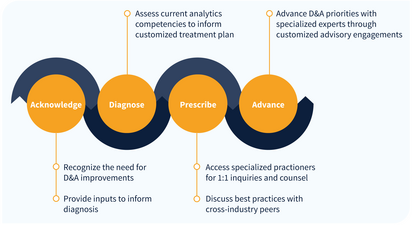Client Inquiry:
How do we make sure we’re focusing our attention on the right AI use cases in a heavily regulated industry? We’re looking for guidance on valuation methods and tools an organization can use to determine if they are focusing on the right areas. If they are, what sort of value can they expect from an investment in a particular capability?
Expert Takeaways:
1. Focus on Human Augmentation, Not Full Automation
Most of the value being generated by AI today—especially in regulated industries like healthcare—is in augmenting human decision-making, not replacing it. Use cases such as contact center summarization, anomaly detection, and operational efficiency are thriving because they help people make faster, more consistent decisions. The technology is capable of more, but organizational and compliance considerations demand a human-in-the-loop model. That’s not a shortcoming—it’s a strategic advantage in the current environment.
- Frame AI initiatives as “bicycles for the mind”—tools to extend human capacity, not bypass it.
- Focus near-term efforts on augmentative use cases with measurable decision impact, especially where consistency and speed matter.
- Don’t chase full automation prematurely; regulated enterprises must retain human checkpoints to ensure trust, compliance, and interpretability.
- Prioritize use cases where internal proprietary data can enhance off-the-shelf models, especially in GenAI.
2. Tie Valuation Metrics to Strategic KPIs and Feasibility
Many AI teams struggle to prove value because they frame success around technical outputs instead of business outcomes. The key is to anchor your AI use cases to core strategic or operational KPIs—and track both feasibility and impact. A balanced portfolio of “quick win” and long-horizon projects can demonstrate value early while sustaining longer-term investments. Don’t just deliver the work—continuously communicate the impact.
- Align AI use cases to strategic enterprise KPIs to show how AI contributes to business goals.
- Develop a prioritization framework that scores both business value and implementation feasibility.
- Use a portfolio approach: balance short-term wins (1–2 quarters) with longer-term strategic bets.
- Track and socialize value consistently—consider impact dashboards, newsletters, or even a “value thermometer” to build awareness and advocacy.
3. Push Value Accountability to the Business and Prioritize Partners Who Embrace It
AI teams often serve as enablers, not owners, of business value realization. While analytics leaders should require clearly defined business problems, executive sponsorship, and pro forma ROI estimates before committing resources, they shouldn’t take full responsibility for tracking downstream value. Instead, embed accountability with business stakeholders—and use that discipline as a criterion for prioritization.
- Require every AI initiative to start with a real business sponsor and documented value hypothesis (e.g., FTE savings, cycle time reductions, increased revenue).
- Build simple but credible tracking mechanisms that compare before-and-after performance—leveraging operational metrics like time saved or customer handle time when direct financials aren't possible.
- Encourage the business to own the thermometer: they should be responsible for validating and reporting realized value against initial projections.
- Track internal stakeholder maturity and reward those who reliably document outcomes. Consider allocating more delivery capacity to these partners, especially when resources are constrained.
- Use your reporting line through finance to reinforce credibility—especially when pushing for disciplined prioritization and consistent value measurement across domains.
4. Anchor Your Portfolio in Clear Value Paths—and Don’t Lose Sight of the End User
AI teams need a balanced portfolio of projects to deliver results today, invest in the future, and maintain innovation momentum. A 60/30/10 approach—60% near-term value, 30% longer-term strategic bets, and 10% innovation—creates room for experimentation without losing executive confidence. But even within that structure, project selection should be grounded in practical, user-facing needs and visible business impact.
- Focus your AI efforts on use cases that clearly help people get something done—don’t lose that connection to the end user.
- Organize your portfolio to show both quick wins and strategic progress. Ensure each initiative connects to one of two core aims: improving analytics or enabling better decisions.
- When evaluating use cases, ask whether the AI will help you interpret, accelerate, or summarize complex processes. Customer service, call center, and CSAT improvements remain ripe areas in regulated industries like healthcare for this type of augmentation.
- Be intentional about when to constrain the data and when to open things up—use case–grounded data can keep models lean and focused, but exploratory work with broader datasets can surface new insights and value drivers.
- Use quarterly capability assessments across your analytics and business partners to spot gaps, maintain momentum, and align on evolving needs.
Expert Network
IIA provides guided access to our network of over 150 analytics thought leaders, practitioners, executives, data scientists, data engineers with curated, facilitated 1-on-1 interactions.
- Tailored support to address YOUR specific initiatives, projects and problems
- High-touch onboarding to curate 1-on-1 access to most relevant experts
- On-demand inquiry support
- Plan validation and ongoing guidance to advance analytics priority outcomes
- Monthly roundtables facilitated by IIA experts on the latest analytics trends and developments
